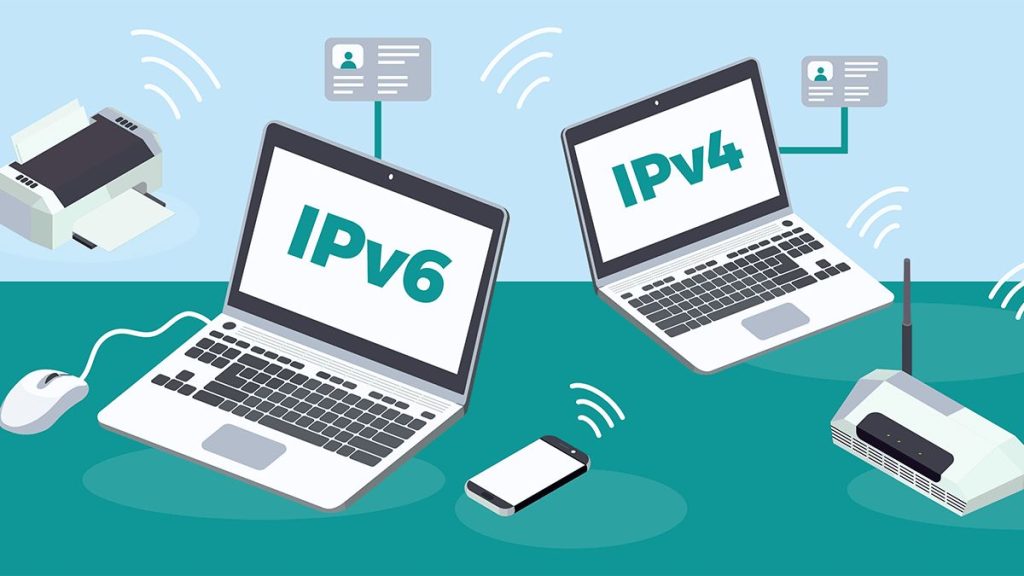The Internet Protocol or shortened IP allows computers to communicate through the internet. There are two types of IPs – IPv4 and IPv6. In theory, IPv6 is more advanced, and it’s known to provide an infinite number of addresses, while IPv4 has a limited number of addresses. However, let’s see what the main differences in practice are.

What Is the Difference Between IPv6 and IPv4?
With this information in mind, you might have a general idea on what is the difference between IPv6 and IPv4. The increased number of IP addresses makes IPv6 a far more advantageous option than IPv4. Also, the difference in how they are formatted provides a different quality of communication over the internet.
With these significant characteristics, there are some advantages and drawbacks to the overall results they provide in the connection. Below are some of the most notable ones:
IPv6 offers a revolutionary larger number of IP addresses compared to IPv4
We did mention that one of the most significant characteristics of IPv6 is the larger number of IP addresses. While the IPv4 has only 4.3 billion IP addresses, the IPv6 offers over 340 undecillion IP addresses.
This number should suffice for more than a trillion internet devices in the near future, which can be a preferable option in the development of new products and technologies.
IPv6 comes with implemented security which is far safer than the IPv4
Since online security is paramount, the IPv6 was developed with a series of security protocols that make it far safer than the IPv4 to promote data integrity and authentication. This is due to the in-built IPsec, while in IPv4 it is optional.
Not all routers support the IPv6
The IPv6 is compatible with almost all operating systems like Windows Vista, Linux, and Mac OS X; however, the only problem is that not all routers are configured to support this IP address.
In this case, even if you have a suitable operating system, there is a great chance that your router won’t support it. In this case, you need to check with your ISP provider.
The battle regarding the speed – The IPv6 is possibly faster than the IPv4
A series of tests resulted in surprising outcomes regarding which one of the two IP address options is faster. Most of the results delivered almost the same speed in a direct connection; however, further observation delivered by various studies suggests that IPv6 is faster.
Experts explain this to be due to the bigger packets that the IPv6 complexion provides.
There is a debate that of not so bright future of the IPv6
Even though at first glance we can say that IPv6 can bring far more convenience in terms of speed and security, according to the experts, they don’t see much bright future for its usage mainly because replacing the IPv4 equipment with IPv6 is especially time-consuming and costly.
Read more: How to Enable IPV6 on Router

IPv6 and IPv4 in Definition
What is IPv6?
The IPv6 is the most advanced version of the Internet Protocol. It’s an entirely new technology developed with the idea to replace IPv4 address-identifying devices across the internet and allow them to be easily located. In that respect, the internet is identified through its IP address so it can work.
The Internet Engineering Task Force developed the IPv6 after spotting a lack of IP addresses. They’ve created IPv6 to offer far more advanced features than IPv4, using eight groups of four hexadecimal digits separated by colons, unlike three-digit numbers as it’s in the case of IPv4.
The IPv6 format
The IPv6 format includes both letters and numbers and can look something like this: FE80:CD00:0000:0CDE:1257:0000:211E:729C..
The IPv6 is split into parts: a network and node components. The network component is used for routing and contains the first 64 bits of the address, while the node component is derived from the physical address and is used to identify the address of the interface using a 64 bit extended unique identifier.
What is IPv4?
As we mentioned before, the IPv4 was introduced years before the IPv6 as a standardized way for the computers on the internet to communicate with each other. It uses the best effort delivery through a connectionless protocol, sending the data without the requirement of third parties into the connection establishment; most notably, it uses only a small amount of memory.
Originally it provided over 4 billion unique addresses, which wasn’t enough supply back in the days, which resulted in the development of the IPv6.
The IPv4 format
The typical format of the IPv4 includes 32-bit numbers containing decimal digits formatted as four 8-bit fields separated by periods. Identically to the IPv6, the IPv4 address is also split into two parts: a network and a host.
The first part of the IPS addresses is the network part specifies which network this IP address belongs to.
As you might guess, the host part identifies the device you are connected to on your network.
Also read: Which Is Faster Ethernet or Wi-Fi?
Conclusion
What is the difference between IPv6 and IPv4? To conclude, there is still more to uncover, but in many cases, you don’t need to worry too much. Despite the weakening capacity of the IPv4, it’s still much more commonly used than the IPv6 as far as it is functional since the majority of websites and applications only support this type of IP address.
As for performance, there is not much difference between these two that you might find especially noticeable. Yes, the IPv6 is much more modern, and if you have a choice, the sites you want to access support this protocol. However, you must be aware that the shifting process can be long and complicated.
On the other hand, if we follow the expert advice, they don’t advise permanently switching to the latest version. Another viable option is to combine both IP addresses, known as a Dual Stack network.